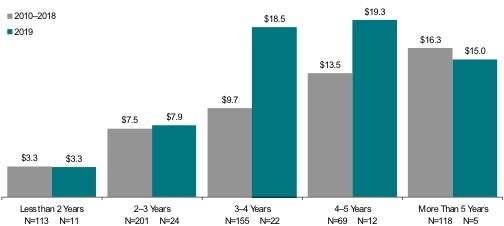In 2019, 15 percent of cases settled within two years of filing, consistent with the rate over the last 10 years. The average time from filing to settlement in 2019 was 3.3 years.
Compared to cases that settled more quickly, cases that required three to five years to settle in 2019 had a higher frequency of factors such as a public pension as a lead plaintiff and/or the presence of a corresponding SEC action.
Only 7 percent of cases in 2019 took more than five years to settle, the lowest rate in the past decade. Of these, 80 percent involved institutional investors. The median assets of the defendant firms in these cases were also substantially higher at $68 billion, compared to a median of $1.2 billion in other cases.
In 2019, cases that took more than five years to settle had a lower median settlement amount than cases that took three to five years to settle. This is despite the higher median “simplified tiered damages” of $602 million for cases that took more than five years to settle, compared to $375 million for cases that took three to five years to settle.
Median “simplified tiered damages” for Rule 10b-5 cases settling in less than two years were substantially smaller compared to settlements that took longer to resolve.
The number of docket entries as of the settlement may reflect case complexity. This factor has also been used in prior research as a proxy for attorney effort.[i] The number of docket entries is highly correlated with the duration from filing to settlement hearing date, issuer size, criminal allegations, accounting allegations, as well as the size of “simplified tiered damages.” Median docket entries for cases settled in 2019 were largely unchanged from prior years, but the average number of docket entries reached its highest level in the past decade.
Figure 12: Median Settlement by Duration from Filing Date to Settlement Hearing Date 2010–2019 (Dollars in millions)

[i] Docket entries reflect the number of entries on the court docket for events in the litigation and have been used in prior research as a proxy for the amount of plaintiff attorney effort involved in resolving securities cases. See Laura Simmons, “The Importance of Merit-Based Factors in the Resolution of 10b-5 Litigation,” University of North Carolina at Chapel Hill Doctoral Dissertation, 1996; Michael A. Perino, “Institutional Activism through Litigation: An Empirical Analysis of Public Pension Fund Participation in Securities Class Actions,” St. John’s Legal Studies Research Paper No. 06-0055, 2006.
Read Cornerstone Research report Securities Class Action Settlements—2019 Review and Analysis.
Securities Class Action Settlement Median Value Remains Historically High in 2019




 />i
/>i

